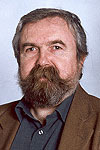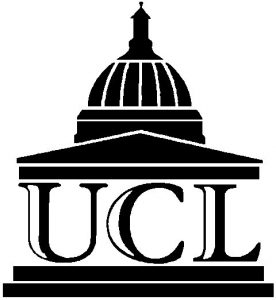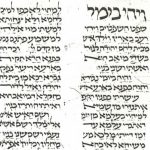Follow this link for the full schedule and abstracts for Targum papers to be delivered at the 2022 IOTS/SBL IM in Salzburg this summer.
Tag Archives: Aramaic
2022 IOTS Conference Call for Papers
Call for Papers
It is a pleasure for the executive committee of the International Organization for Targumic Studies (IOTS) to invite you to the IOTS conference, connected to the international SBL conference on 17-21 July 2022 in Salzburg. The conference will accept proposals on the following topics:
- Targums of the Tora
- Targum and Qumran
- Targum Studies: Past and Present
but papers on other related topics are also welcome. Abstracts of no more than 300 words can be sent to Eveline van Staalduine-Sulman (e.van.staalduine-sulman@vu.nl) before 1 March 2022.
Derek R. G. Beattie, d. 31 August 2019. A scholar who will be greatly missed.
From Christian Brady:
This past week I received word from Paul Flesher that Derek Beattie died on Saturday, 31 August at his home in Chandler’s Ford, Hampshire. He was 73 years old. His son has said that plans for the funeral are still in process, but it is likely to be on 13th September.
One of my great regrets now will always be that I was unable to meet Derek in person. We corresponded quite a bit while I was working on Targum Ruth and Derek was incredibly gracious to me. The Book of Ruth and its rabbinic interpretation, especially the Targum, was a subject he knew more about than perhaps any person living. It began with his doctoral work (see Jewish Exegesis of the Book of Ruth) and continued right until the end. In the last few years I know that the had been hoping to complete his commentary on Targum Ruth.
Derek always kindly responded to my emails, offering corrections and suggestions on my work, and was even willing to make his critical edition of Targum Ruth available to me for publication. (In the end I simply provided a transcription of the base manuscript, but his work was often referenced in my volume.) I am so grateful to have corresponded with him and only wish I had truly gotten to know him.
His faculty page at Queen’s University Belfast, where he was a longtime faculty member, has this bio.
Derek read Hebrew and Semitic (formerly Oriental) Languages at Trinity College, Dublin, in the heyday of Jacob Weingreen’s Honor School, then migrated to St Andrews where he took his PhD under the supervision of William McKane. After a brief period as a lecturer in the University of Aberdeen he was appointed to a lectureship in Semitic Studies at Queen’s University Belfast in 1973 and was head of the Department of Semitic Studies from 1985 until its absorption in the school of Greek, Roman & Semitic [subsequently Byzantine] Studies.
As a very meagre memento, below is the bibliography that I have of Derek’s work. I am certain it is incomplete and welcome additions from readers.
Bibliography

Beattie, D R G. “Kethibh and Qere in Ruth IV 5.” Vetus Testamentum21, no. 4 (1971): 490-494.
Beattie, D R G. “The Book of Ruth as Evidence for Israelite Legal Practice.” Vetus Testamentum24, no. 3 (1974): 251-267.
Beattie, D R G, Jewish Exegesis of the Book of Ruth.Sheffield: Sheffield University, 1977.
Beattie, D R G. “Midrashic Gloss in Ruth 2:7.” Zeitschrift fur die alttestamentliche Wissenschaft89 (1977): 122-124.
Beattie, D R G. “Redemption in Ruth, and Related Matters: A Response to Jack M. Sasson.” Journal for the Study of the Old Testament5 (1978): 65-68.
Beattie, D R G. “Ruth III.” Journal for the Study of the Old Testament5, no. 39-48 (1978): 39-48.
Beattie, D R G. “The Targum of Ruth: A Sectarian Composition?”. Journal of Jewish Studies36, no. 2 (1985): 222-229.
Beattie, D R G. “The Targum of Ruth – 18 Years On.” Hermathena (1985): 57-61.
Beattie, D R G. “Towards dating the Targum of Ruth,” in Word in Season. Sheffield, JSOT Press, 1986, 205-221.
Beattie, D R G. “Ancient Elements in the Targum to Ruth,” Pages 159-165 in Proceedings of the Ninth World Congress of Jewish Studies, Jerusalem, August 4-12, 1985. Jerusalem: World Union of Jewish Studies, 1986.
Beattie, D R G. “Ruth 2:7 and midrash.” Zeitschrift für die alttestamentliche Wissenschaft, 99 (1987): 22-423.
Beattie, D R G. “The Yemenite Tradition of Targum Ruth.” Journal of Jewish Studies41, no. 1 (1990): 49-55.
Beattie, D R G. “The Textual Tradition of Targum Ruth,” in Aramaic Bible(Sheffield, JSOT Pr), 1994, 340-348.
Beattie, D R G, The Targum of Ruth.Vol. 19. Collegeville: Liturgical, 1994.
Beattie, D R G. “Baldrick and Blackadder revive an ancient exegetical question relating to Ruth.” Belfast Byzantine Texts and Translations9 (2000).
Beattie, D R G. “The Targum Ruth: A Preliminary Edition,” Pages 231-290 in Targum and Scripture: Studies in Aramaic Translations and Interpretations in Memory of Ernest G. Clarke. Edited by Paul VM Flesher. Leiden: Brill, 2002.
Beattie, D R G and P R Davies. “What Does Hebrew Mean?”. Journal of Semitic Studies56, no. 1 (2011): 71-83.
Beattie, D R G and M J McNamara, The Aramaic Bible: Targums in their Historical Context.Sheffield, UK: Sheffield Academic Press / JSOT Press, 1994.
Conference Programme: Targum Studies in London, IOTS 2018
Conference Programme: Targum Studies in London, IOTS 2018
In consultation with the Institute of Jewish Studies, the International Organization for Targumic Studies announces a summer meeting at University College London, 9-12 July 2018 (the conference will start with an evening lecture on July 9th). The full programme can be found and downloaded here: http://blogs.ucl.ac.uk/hebrew-jewish-research-blog/2018/04/15/targum-studies-in-london-iots-2018/
The focus of this meeting will be on two related issues:
The Aramaic dialects within their Late Antique environment
The development of the Targums within their wider interpretative milieu.
The study of the local influences on the dialect of Onqelos and Jonathan, long considered to represent a direct development of Middle Aramaic, and sometimes held to reflect little to no signs of any specific provenance (Western, Eastern, Central Aramaic), is attracting renewed attention, which warrants the re-opening of the question about these Targums’ dialect and provenance.
Moreover, the provenance and integrity of the dialect of the Late Targums remains unsolved. These days their Aramaic is considered a learned, written dialect divested from a vernacular basis, but despite arguments of a considerable Syriac influence, its provenance is as yet unclear.
At the literary and exegetical level, the milieu of composition and transmission raises questions about the meaning of parallels between targumic and non-targumic exegesis. Exactly how does targumic exegesis relate to its rabbinic parallels? What are the differences in terms of contents, context, presentation, and narrative arc? The mere observation that parallels exist does not analyse the relationship at a level that is anywhere near profound enough to be meaningful.
Beyond the old questions of literary dependence, we still need to establish whether targumic exegesis reflects signs of a non-rabbinic, late rabbinic or other specific local environment. In spite of the evidently close connection between targumic and rabbinic exegesis, questions linger about the precise relationship between the Targums and the rabbinic milieu, whether in Roman Palestine, Babylonia or Jewish communities elsewhere, and the wider society in which they took shape and to which they inevitably responded. This conference seeks to address these questions and many more.
020 7679 3520
Booking through Eventbrite is advised—details to be announced.
9th International Meeting of the International Organization for Targum Studies
9th International Meeting
International Organization for Targum Studies (IOTS)
July 9-11, 2018, University College London
NB: The meeting will start in the evening of July 9th.
CALL FOR PAPERS
We are pleased to announce a call for papers related to Targum and Cognate Studies. We particularly invite paper proposals with a thematic focus on one of two closely related and increasingly topical aspects of the contents and language of the Targums:
The Aramaic dialects within their Late Antique environment;
The development of the Targums within their wider interpretative milieu.
In keeping with former IOTS meetings, we also issue an open call for paper proposals by scholars who wish to present their research on any topic in the field of Targum Studies.
The Aramaic dialects within their Late Antique environment The study of the local influences on the dialect of Onqelos and Jonathan, long considered to represent a direct development of Middle Aramaic, and sometimes held to reflect little to no signs of any specific provenance (Western, Eastern, Central Aramaic), is attracting renewed attention, which warrants the re-opening of the question about these Targums’ dialect and provenance. Moreover, the provenance and integrity of the dialect of the Late Targums remains unsolved. These days their Aramaic is considered a learned, written dialect divested from a vernacular basis, but despite arguments of a considerable Syriac influence, its provenance is as yet unclear.
The development of the Targums within their wider interpretative milieu At the literary and exegetical level, the milieu of composition and transmission raises questions about the meaning of parallels between targumic and non-targumic exegesis. Exactly how does targumic exegesis relate to its rabbinic parallels? What are the differences in terms of contents, context, presentation, and narrative arc? The mere observation that parallels exist does not analyse the relationship at a level that is anywhere near profound enough to be meaningful.
Beyond the old questions of literary dependence, we still need to establish whether targumic exegesis reflects signs of a non-rabbinic, late rabbinic or other specific local environment. In spite of the evidently close connection between targumic and rabbinic exegesis, questions linger about the precise relationship between the Targums and the rabbinic milieu, whether in Roman Palestine, Babylonia or Jewish communities elsewhere, and the wider society in which they took shape and to which they inevitably responded.
Location and hospitality
The conference will be organized under the auspices of the IOTS by the Institute for Jewish Studies (IJS) at University College London. Hospitality will be available via the IJS at the Tavistock Hotel in Bloomsbury, for £85 a person a night; please contact the IOTS at the address below. To take advantage of this discounted price, early reservations via our organization are recommended. Details to follow.
How to submit paper proposals
Papers should be of twenty-minutes length, allowing ten additional minutes for discussion. All proposals should include title, speaker, academic affiliation, and a short abstract of 200- 250 words. This call for papers will remain open until 31 December 2017. Please send your proposal to: Professor Willem Smelik, Email: willem.smelik@ucl.ac.uk; postal address (until May 1, 2018): 17 Gray Street, #3, Cambridge MA, 02138 USA.
Download Announcement: 9thIOTSConference
Valmadonna Collection Purchased by the National Library of Israel – Targum MS in Museum of the Bible
This is very good news! It appears the entire collection has been purchased by the Israeli National Library. Several years ago Sotheby’s was exhibiting and the family seeking to sell this incredibly important collection. It is particularly important for Targum scholars because it includes Valmadonna 1 (formerly Sassoon 282). UPDATE: That is NOT the case. Valmadonna 1 was purchased by the Museum of the Bible: Codex Valmadonna 1. The Sotheby’s catalogue described the manuscript as follows:
The jewel in the Valmadonna Library’s crown is one of the most important privately-owned books in the world – a Pentateuch (Hebrew Bible), written in England the summer of 1189. Known as the Codex Valmadonna I, this extraordinary book is the only dated Hebrew text in existence from medieval England, before King Edward I’s 1290 edict expelling the Jews.
It is a massive collection and many scholars were worried it would be separated and go into private collections. This should ensure access and enable new research going forward. The JC article shares a few more details about the collection and the owner, Jack Lunzer, who recently passed away.
The Valmadonna Trust Library, widely regarded as the finest private collection of Hebrew books and manuscripts in the world, was assembled by Jack Lunzer, who spent more than six decades assembling it.
The vast collection charts the spread of Hebrew printing around the world and includes 550 broadsheets and newspapers dating back as far as the 16th century.
Hailing the purchase, Oren Weinberg, director of the National Library of Israel said: “The Valmadonna Trust Library represents an historic addition to our leading collection of Jewish manuscripts, prints and books, which reflect and embody the cultures of the Jewish people around the world and across the ages.”
Mr Lunzer, who died last month at the age of 92, was born in Antwerp and made his fortune as a young man in the diamond industry in London. He named his collection after the town of Valmadonna in northern Italy, where he and his wife Ruth Zippel, had connections. In 2015 Mr Lunzer sold his 16th century Babylonian Talmud, made by the Christian printer Daniel Bomberg, for US$9.3 million (£7.5 million).
SBL 2013 – Aramaic Studies Session
The preliminary Program Book for SBL 2013 in Baltimore is up. There will be quite a few papers in various sessions related to Aramaic and Aramaic studies. The AS Session has a strong line up:
S24-206
Aramaic Studies
11/24/2013
1:00 PM to 3:45 PM
Room: 312 – Convention Center
After the papers have been delivered, there will be a brief presentation on the history of the Aramaic Studies section.
Edward Cook, Catholic University of America, Presiding
Binyamin Y. Goldstein, Yeshiva University
The Significance of Late Medieval Witnesses for the Textual Study of the Targumim (30 min)Catherine E. Bonesho, University of Wisconsin-Madison
The Altar to Sol: No Longer to Malakbel, a New Translation of the Palmyrene Inscription of PAT 0248 (30 min)
Andrew D. Gross, The Catholic University of America
The Legal Traditions of Nabatean-Aramaic: Something New, Something Old, or Something Borrowed? (30 min)
Leeor Gottlieb, Bar-Ilan University
Pseudo-Jonathan’s Direct Literary Influence on Targum Chronicles (30 min)
Moshe J. Bernstein, Yeshiva University
Stylistic Features in the Narrative of the Genesis Apocryphon (30 min)


